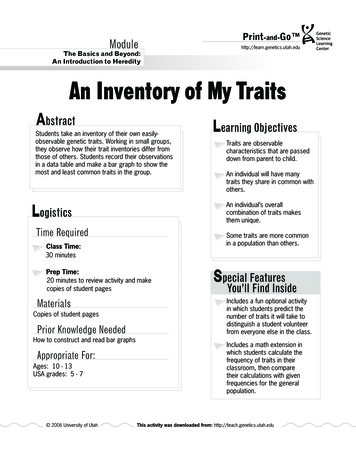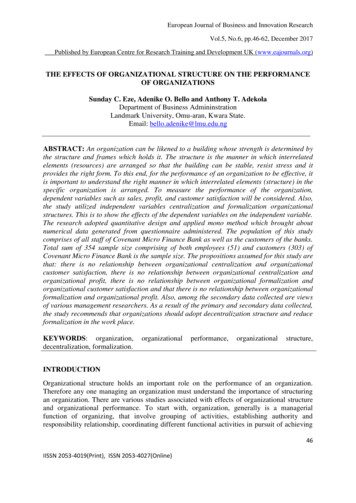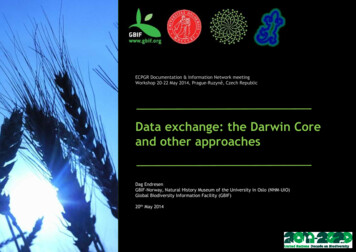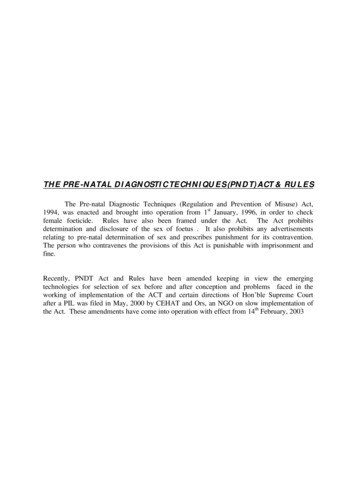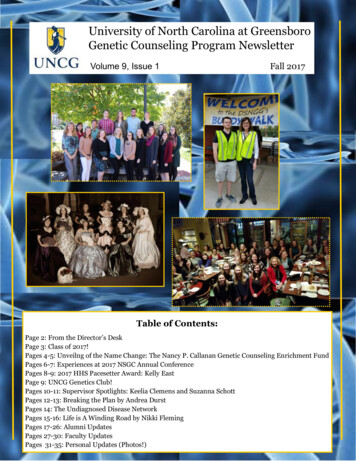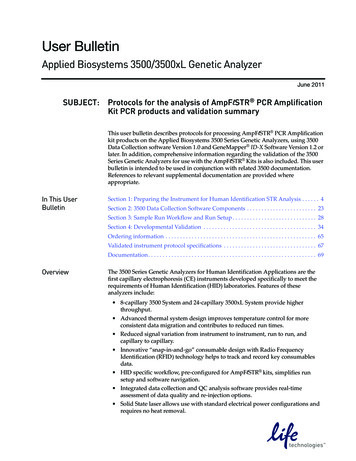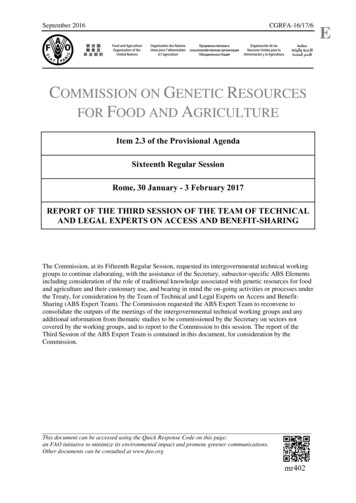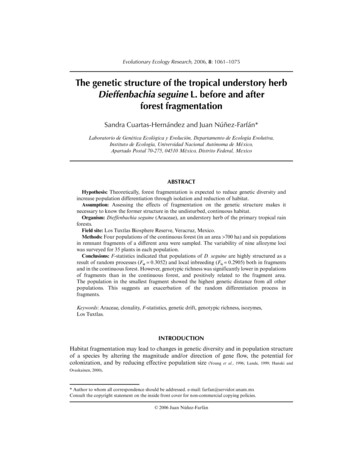
Transcription
Evolutionary Ecology Research, 2006, 8: 1061–1075The genetic structure of the tropical understory herbDieffenbachia seguine L. before and afterforest fragmentationSandra Cuartas-Hernández and Juan Núñez-Farfán*Laboratorio de Genética Ecológica y Evolución, Departamento de Ecología Evolutiva,Instituto de Ecología, Universidad Nacional Autónoma de México,Apartado Postal 70-275, 04510 México, Distrito Federal, MexicoABSTRACTHypothesis: Theoretically, forest fragmentation is expected to reduce genetic diversity andincrease population differentiation through isolation and reduction of habitat.Assumption: Assessing the effects of fragmentation on the genetic structure makes itnecessary to know the former structure in the undisturbed, continuous habitat.Organism: Dieffenbachia seguine (Araceae), an understory herb of the primary tropical rainforests.Field site: Los Tuxtlas Biosphere Reserve, Veracruz, Mexico.Methods: Four populations of the continuous forest (in an area 700 ha) and six populationsin remnant fragments of a different area were sampled. The variability of nine allozyme lociwas surveyed for 35 plants in each population.Conclusions: F-statistics indicated that populations of D. seguine are highly structured as aresult of random processes (Fst 0.3052) and local inbreeding (Fis 0.2905) both in fragmentsand in the continuous forest. However, genotypic richness was significantly lower in populationsof fragments than in the continuous forest, and positively related to the fragment area.The population in the smallest fragment showed the highest genetic distance from all otherpopulations. This suggests an exacerbation of the random differentiation process infragments.Keywords: Araceae, clonality, F-statistics, genetic drift, genotypic richness, isozymes,Los Tuxtlas.INTRODUCTIONHabitat fragmentation may lead to changes in genetic diversity and in population structureof a species by altering the magnitude and/or direction of gene flow, the potential forcolonization, and by reducing effective population size (Young et al., 1996; Lande, 1999; Hanski andOvaskainen, 2000).* Author to whom all correspondence should be addressed. e-mail: farfan@servidor.unam.mxConsult the copyright statement on the inside front cover for non-commercial copying policies. 2006 Juan Núñez-Farfán
1062Cuartas-Hernández and Núñez-FarfánFollowing subdivision by fragmentation, local populations could change their levelof genetic differentiation depending on the rate of gene flow (Young et al., 1996). If gene flowincreases among fragmented populations, it may reduce or eliminate population differentiation, maintaining genetic diversity (Foré et al., 1992; White et al., 1999) and acting againstdrift or diversifying selection (Richards, 2000). In contrast, if gene flow is reduced by fragmentation, differentiation among populations may increase. A reduction in gene flow can occurthrough changes in the abundance and activity pattern of pollinator species (Murcia, 1996;Knutsen et al., 2000). Reduced gene flow and small effective sizes of populations in fragmentsmay lead to inbreeding and drift, and a subsequent erosion of genetic variation (Ellstrand andElam, 1993; Young et al., 1996; Rosquist and Prentice, 2000).Loss of genetic diversity can compromise the persistence of local populations (Young et al.,1996; Young and Clarke, 2000) by limiting their ability to respond adaptively to the varying localconditions (Rosquist and Prentice, 2000) and increasing the risk of extinction due to inbreedingdepression (Ellstrand and Elam, 1993). Thus, knowledge about the impact of habitat fragmentationon genetic diversity and structure of populations has direct implications for the conservation and management of species, by offering insights into the evolutionary and ecologicaldynamics (Neel and Ellstrand, 2001).Empirical studies of the genetic consequences of habitat fragmentation in plantshave revealed that genetic variability tends to decrease in small populations, althoughfragmentation does not necessarily lead to genetic losses (Young et al., 1996). These differentresponses to fragmentation are due to the variety and complexity of reproductive strategies(sexual and asexual) and mating system (outcrossing, selfing or mixed), combined withdifferences in population sizes, seed dispersal, and pollination systems (Young and Clarke, 2000).Moreover, the population genetic structure of a species before fragmentation is often notknown (due to the lack of large areas of forest); in cases where genetic structure as producedby fragmentation can be identified, the former structure of populations preceding habitatchange may be evident.The effects of fragmentation on genetic variation and structure are well known fortemperate herbs (e.g. van Treuren et al., 1991; Raijman et al., 1994; Young et al., 1999; Rosquist and Prentice, 2000)and tropical tree species (Prober and Brown, 1994; Boshier et al., 1995; Hall et al., 1996; Aldricht et al., 1998;Shapcott, 1998; White et al., 1999). However, the genetic effects of fragmentation have not beenevaluated in tropical herbs (Shapcott, 1998; Young et al., 1999), despite understory species being themost diverse structural component in the tropical rain forests (Ibarra-Manríquez et al., 1997).Moreover, the shorter life span of herb plant species makes it possible to evaluate theeffect of fragmentation on the genetic structure of the derived generations compared withlong-lived trees or shrub species.The aim of the present study was to assess the impact of habitat fragmentation on thegenetic diversity and structure of a tropical understory herb, in the Los Tuxtlas tropical rainforest. Given the effect of fragmentation on gene flow, we anticipated: (1) a reduction ingenetic diversity, an increment in the genetic differentiation among populations, andincreased inbreeding in populations of fragments compared with populations in thecontinuous forest; and (2) an inverse relationship between the size of the fragment and themagnitude of the genetic effect.The Los Tuxtlas region has been heavily deforested over the last 30 years, producing ahighly patchy landscape. However, the region constitutes an excellent system to test ourhypothesis because there are still some large areas of continuous undisturbed forest( 640 ha) and fragment remnants of different sizes (range 0.3–134 ha). The Los Tuxtlas is
Genetic structure of a tropical understory herb1063an important area for preservation because it is the boreal limit of the tropical forests inAmerica, and because it has a high species diversity of tropical and temperate origins andsome endemics (Gonzáles et al., 1997).We used isozyme variation to analyse four populations within the continuous forest todetermine the former genetic variation and structure of the populations in an undisturbedforest, and six populations in fragments of different sizes to assess the effect of fragmentation on genetic structure. The comparison of the genetic dynamics of populations incontinuous forest in relation to fragments allows us to assess, without overestimating theresults, changes in the genetic variation and structure in populations of this species due tohabitat reduction and isolation.METHODSSpecies descriptionDieffenbachia seguine is an understory clonal herb of neotropical rain forests. It ranges fromsouthern Mexico to Guyana, Brazil, and Ecuador (Mayo et al., 1997). This species forms largeaggregations. New ramets arise from broken rhizomes. Each ramet produces one to fourinflorescences in a flowering season, depending on the plant’s size (Cuartas, 2002). The openingof a given inflorescence on a ramet does not coincide with another inflorescence of thesame ramet. Female and male flowers are located at the base and the tip of the spadix,respectively. Female flowers are receptive before pollen is released – that is, they areprotogynous. To our knowledge, no studies have been published regarding the reproductivebiology and mating system of D. seguine. The genus Dieffenbachia is pollinated byscarab beetles of the genera Cyclocephala and Erioscelis. The reproductive biology ofDieffenbachia is detailed in Young (1988, 1990). Fruits are red when mature and dispersed byunderstory birds of the genera Turdus and Habia (R. Estrada-Coates, personal communication).Study site and field collectionThe study was conducted at the Los Tuxtlas Biosphere Reserve located in the state ofVeracruz in the Gulf of Mexico (Fig. 1). In the Los Tuxtlas region, continuous tropicalrain forest has been reduced to some isolated remnants due to the conversion of land intocattle grazing and sugar cane plantations (Gonzáles et al., 1997). However, three large areas ofundisturbed forest still remain (San Martín Volcano, San Martín Pajapan Volcano, andSierra Santa Martha).To asses the effect of geographic isolation on the genetic structure, ten populations ofD. seguine from a wide geographic area were sampled within the Biosphere Reserve (Table 1,Fig. 1): four populations in the continuous forest within the Los Tuxtlas Tropical BiologyStation (separated by a mean distance of 6.08 km from one another) and six populationsfrom the few remaining remnant fragments with minimal disturbance. Four fragments arelocated in the vicinity of the Station (5.98 km in average), while two are located somedistance from the Station (24.7 km on average) in the Sierra Santa Martha. Sampling wascarried out in the centre of each fragment.For genetic analyses, leaves of 35 plants on average were sampled in each population.Haphazardly, a plant was collected every 10 m to prevent the collection of two ramets of thesame genet. Clonality was not specifically examined; however, some conclusions could bemade from our results.
1064Cuartas-Hernández and Núñez-FarfánFig. 1. Map of the Los Tuxtlas Biosphere Reserve in the State of Veracruz, Mexico. The populationsof Dieffenbachia seguine sampled in the fragments (F ) and continuous forest (C) are indicated. Thestippled area highlights the area of remaining tropical forest. The horizontal line is equivalent to 4 km.Table 1. Geographic position and area of D. seguine populations sampled in Los Tuxtlas, MexicoPopulationEstaciónLagunaPedregalSan MartínCascadaPlayaSanta Martha 1Santa Martha 2CerroRuíz CortínezSymbolNGeographic positionArea (ha)C1C2C3C4F1F2F3F4F5F64030303930304040303018 35 240 N, 95 04 620 W18 35 245 N, 95 05 912 W18 34 347 N, 95 07 776 W18 31 357 N, 95 10 675 W18 34 692 N, 95 03 973 W18 35 050 N, 95 02 600 W18 32 676 N, 95 07 328 W18 22 025 N, 94 57 781 W18 37 739 N, 95 05 157 W18 36 730 N, 95 05 821 W6406406406400.3352037.4114.6Note: N is the number of sampled individuals.
Genetic structure of a tropical understory herb1065Genetic markersHorizontal starch-gel electrophoresis was used to obtain allozyme data for 35 plants perpopulation following standard methods (Cheliak and Pitel, 1984). The extraction buffer was a 3 : 1mixture of the YO and VEG II buffers, respectively (Yeh and O’Malley, 1980; Cheliak and Pitel, 1984). 1Extracts were centrifuged at 7000 rev · min for 7 min and the supernatant was absorbed bypaper wicks. Samples were run on starch gels (9% w/v) at 4 C. Nine polymorphic loci ofseven enzymes displayed reliable banding patterns. The buffer system Histidine pH 6.5 (runfor 7 h) (Stuber et al., 1988) was used for the enzymes glutamate dehydrogenase (GDH) E.C.1.4.1.2 (one locus), malate dehydrogenase (MDH) E.C. 1.1.1.37 (two loci), and malicenzyme (ME) E.C. 1.1.1.40 (one locus). The buffer system Poulik pH 8.6 (run for 4 h)(Hakim-Elahi, 1976) was used for anodal and cathodal peroxidase (APX and CPX) E.C. 1.11.1.7(one and two loci, respectively), glutamate oxalacetate dehydrogenase (GOT) E.C. 2.6.1.1(one locus), and esterase (EST) E.C. 3.1.1 (one locus).Statistical analysisWe obtained the multi-locus genotype for each individual of D. seguine, based on theobserved banding patterns for each enzyme locus. Allelic frequencies were estimated fromthe genotypic frequencies and used to calculate the genetic parameters using the programTPFGA 1.3 (Miller, 1997). Four measures of genetic variation were estimated for eachpopulation: polymorphism (P, 95% criterion), mean number of alleles per locus (A),observed mean heterozygosity (Ho), and the expected mean heterozygosity (He) at theHardy-Weinberg equilibrium. The deviation of the observed genotypic frequencies fromrandom mating expectations was tested using a χ 2 goodness of fit (Zar, 1999), and thencalculating the fixation index F 1 (Ho/He) (Wright, 1951).To assess the amount of clonal diversity within populations, we estimated the proportionof distinguishable genotypes G/N (i.e. probability that a newly sampled individual wouldhave a new genotype), where G is the number of different multi-locus genotypes and N isthe number of individuals sampled in each population. G/N ranges from nearly zero inpopulations where only a single genotype is encountered, to 1 in populations where eachindividual is unique (Pleasants and Wendel, 1989). Additionally, we calculated the average diversityof genotypes for fragments and continuous forest using the Shannon-Weiner index; thisapproximation is appropriate when sample sizes are different (Kikkama, 1986).The hierarchical population genetic structure is described by means of the unbiasedstatistics F, θ, and f, corrected for population size, number of alleles per locus, and numberof populations (Weir and Cockerham, 1984), and are equivalent to Wright’s F-statistics Fit, Fst, andFis, respectively (Wright, 1951, 1965). We calculated 95% confidence intervals for these estimatesby means of a jackknife procedure across loci (Weir, 1990). To determine whether the Fit and Fisvalues were significantly different from zero, a χ 2 test was performed for each locus:χ 2 F [2N]*[k 1]with k(k 1)/2 degrees of freedomwhere N is the sample size and k is the number of alleles (Weir, 1990). The departure of the Fststatistic from zero was determined using the χ 2 method of Workman and Niswander (1970):χ (2N) Fst(k 1)2with (k 1)(s 1) degrees of freedomwhere s is the number of subpopulations.
1066Cuartas-Hernández and Núñez-FarfánThe average gene flow Nm (number of individuals exchanged between populations pergeneration) was estimated from Fst values, using the equationFst 1/(4Nmα 1)where α [n/(n 1)] and n is the number of populations (Wright, 1951, 1965; Crow and Aoki, 1984). Inaddition, we estimated the rate of outcrossing (t), assuming that self-fertilization is the onlysource of inbreeding ast (1 f )/(1 f )where f is the inbreeding coefficient (Haldane, 1924). Finally, Nei’s (1972) genetic distance (D) wasestimated among all pairs of populations. A population dendrogram was constructed usingan UPGMA (unweighted pair-group method with arithmetic averaging) procedure, basedon the genetic distances among populations (Hedrick, 2000). The correlation between the matrixof genetic distance and the matrix of geographical distance among populations was testedusing a Mantel’s test (Manly, 1994).Estimates of genetic diversity and population structure were obtained across individualpopulations (local scale), type of habitat (continuous forest and fragments), and allpopulations (global scale). Differences in the estimates of genetic variation between fragmented and continuous forest populations were tested with a t-test, given that all variables,except A and Ho, are normally distributed and with equal variances. For A and Ho, we useda Wilcoxon test. Spearman’s rank correlation was estimated to assess the magnitude of theassociation between the amount of genetic diversity and the size of the fragment (Zar, 1999).RESULTSGenetic diversity in D. seguineNine loci analysed for D. seguine were polymorphic, possessing two or three alleles. Somealleles had frequencies less than 5% or were absent in some populations, either in thefragmented or in the continuous forest (Fig. 2). For most loci, allele frequencies showedmarked differences between populations. There was no pattern in the allelic frequencies(e.g. fixation) in relation to the type of habitat (continuous forest or fragments) or the size ofthe fragment (Fig. 2).An average of 2.01 alleles per locus across all populations was observed (Table 2). Allelicrichness did not differ between fragments and continuous forest (z 0.113, p 0.9095).Polymorphism at the global level was P 84.44% and ranged from P 66.66% in fragmentsof intermediate size (F2 and F5) to P 100% in some populations of both habitats (Table2). The average polymorphism between continuous forest and fragments was not significantly different (t 0.313, p 0.7626). Observed heterozygosity (Ho) ranged from 0.19 to0.38, with a global mean of 0.24. Expected heterozygosity (He) varied from 0.27 to 0.43,with a global mean of 0.33. There were no significant differences in heterozygosity betweenpopulations in the continuous forest or fragments (Ho: z 1.385, p 0.1650; He: t 0.920,p 0.3839). The heterozygosity values did not show any dependence on the size of thefragment (Table 2).Observed heterozygosities were significantly lower than expected heterozygosities in allD. seguine populations (global: χ 2 8.56, d.f. 1, p 0.005; continuous forest: χ 2 4.93,
Genetic structure of a tropical understory herb1067Fig. 2. Frequency of the most common allele at nine loci in ten populations of Dieffenbachia seguine.Populations are arranged from the smallest to the largest in area (see Table 1). F, fragments;C, continuous forest.d.f. 1, p 0.025; fragments: χ 2 3.95, d.f. 1, p 0.05). Deviation of genotypic frequencies from Hardy-Weinberg expectations showed no tendency to be grouped in any particularpopulation or habitat type.The fixation index was positive in all populations studied, indicating inbreeding and theaverage values did not differ significantly between populations in the continuous forest andfragments (t 1.362, p 0.2103) (Table 2).Genetic diversity of D. seguine expressed as the number of different multi-locusgenotypes was very high. A total of 296 multi-locus genotypes was observed over allpopulations. The average genotypic diversity was G/N 0.853 (Table 2), indicating aprobability of 85% that any individual chosen at random had a new multi-locus genotype(Pleasants and Wendel, 1989). At the population and type of habitat level, G/N showed high values( 0.73). The G/N ratio was statistically lower in populations of fragments than in continuous forest (t 2.373, p 0.0451), indicating a negative effect of fragmentation ongenotypic diversity. The Shannon-Weiner index showed the same trend, indicating lowerdiversity indices for populations in fragments than those in continuous forest (t 3.511,p 0.0082) (Fig. 3a). This implies higher genotypic diversity and/or more even frequenciesin the continuous forest. Furthermore, G/N was significantly and linearly related to the areaof the fragment (r 0.65, p 0.0243) (Fig. 3b).
1068Cuartas-Hernández and Núñez-FarfánTable 2. Genetic diversity estimates for D. seguine populations in Los Tuxtlas, MexicoPopulationAPHoHeFG/NContinuous forestC1C2C3C4MeanStandard 2F3F4F5F6MeanStandard 26GlobalMeanStandard .0290.8530.025Note: A is the mean number of alleles per locus, P is the percentage of polymorphic loci (95%), Ho is the observedheterozygosity, He is the expected heterozygosity, F is Wright’s fixation index, G/N is genotypic richness.Fig. 3. (a) Box-and-whiskers plot of the genotypic diversity (Shannon-Weiner Index) of fragments (F )and continuous forest populations (C). The figure shows median genotypic diversity (lines), 25% to75% quartiles (boxes), and ranges (whiskers). Contained within the boxes are the mean genotypicdiversity and the mean standard error. (b) Relationship between fragment size and genotype richness(G/N 0.81 0.00016 area). 䊊, populations in fragments; 䊉, populations in continuous forest.
Genetic structure of a tropical understory herb1069Genetic structure of D. seguine populationsPopulations of D. seguine are highly structured (Table 3). The global and type of habitat Fit,Fst, and Fis estimates were significantly different from zero for all loci (p 0.05). Overallpopulation estimates of F-statistics indicate an equivalent contribution of local inbreeding(Fis) and population differentiation (Fst) to the global inbreeding (Fit) (Table 3). However,the extent of population differentiation was similar in magnitude for continuous forestand fragments (Table 3). Similarly, there were no significant differences in local inbreedingbetween continuous forest and fragment populations. The outcrossing rate estimated at theglobal level was 0.568, suggesting a mixed mating system in D. seguine populations. Theindirect estimates of average gene flow at the global level (Nm 0.784), among populationsin the continuous forest (Nm 0.874), and fragments (Nm 0.724) suggest low migrationrates and possible effects of genetic drift (Wright, 1951).Genetic distances among populations were high in most cases (global average D 0.225),ranging from 0.043 to 0.491. The average genetic distance (D) among populations was 0.250and 0.241 for the continuous forest and fragments, respectively. High values of D wereobtained even between populations in the continuous forest (e.g. C1 vs. C4, D 0.4866).The minimum D value was observed between the C4 and F5 populations, despite the largegeographic distance between them (13.75 km). The dendrogram based on genetic distancesamong populations (Fig. 4) shows that fragment 1 (F1) is separated from the rest of thepopulations by an average distance of 0.36 km. Similarly, it shows that populations do notgroup together by proximity (with the exception of F3 and F4, 0.5 km apart, both in theSierra Santa Martha) or type of habitat (F or C), as illustrated by C4 and F5. Thus,contrary to expectations, there was no correlation between genetic and geographic distancesamong populations (Mantel test: r 0.1515, p 0.8030).Table 3. Wright’s F-statistics for D. seguine populations in Los Tuxtlas, ***0.2875*** 0.1097***0.7515*** ***0.2437*** 0.232***0.1431*** 0.3765***0.2960***0.3052 0.0964*0.3154 0.1326*0.3121 0.0922*0.2905 0.2125*0.3157 0.2088*0.2420 0.2335*Jackknife standard errorGlobal0.5082 0.1600*Continuous forest0.5314 0.1644*Fragments0.4825 0.1779** P 0.05, *** P 0.0001.
1070Cuartas-Hernández and Núñez-FarfánFig. 4. UPGMA cluster analysis based on Nei’s genetic distance among populations of Dieffenbachiaseguine populations in Los Tuxtlas, Mexico.DISCUSSIONThe most striking result of this study is that populations of D. seguine are highly structuredeven in the continuous forest and were probably structured before fragmentation. Thus,fragmentation has yet to exacerbate genetic differentiation among populations beyond thatprior to population subdivision, contrasting with theoretical expectations (Ellstrand and Elam,1993; Young et al., 1996). Also, we detected that habitat fragmentation has produced a reduction inthe diversity of genotypes of D. seguine, but all other estimates of genetic diversity (allelicrichness, polymorphism, and heterozygosity) showed no reduction in relation to isolation orany reduction in population size.Genetic diversityPopulations of D. seguine from Los Tuxtlas are highly genetically diverse compared withother perennials or monocot species (Hamrick and Godt, 1996). There were no significant differences in genetic diversity among D. seguine populations in continuous forest and fragments.In addition, we did not detect any relationship between genetic variation estimates and thesize of the fragments. A similar response to fragmentation has been reported in the tropicaltree Symphonia globulifera in Costa Rica (Aldricht et al., 1998) and the palm Carpentaria acuminata in Australia (Shapcott, 1998). However, a positive relationship between genetic variationand reproductive population size has been observed in many species [Salvia pratensis andScabiosa columbaria (van Treuren et al., 1991), Eucalyptus albens (Prober and Brown, 1994), Gentianapneumonanthe (Raijman et al., 1994), Phitecellobium elegans (Hall et al., 1996), Swetenia humilis (Whiteet al., 1999), and Rutidosis leptorrhynchoides (Young et al., 1999)], and this trend has been suggestedto result from the elimination of rare alleles in fragmented populations. In contrast, inD. seguine, most loci had alleles at intermediate frequencies, and low-frequency alleles werenot associated with fragmentation.Genotypic diversity in populations of D. seguine is high compared with other clonalplants (Pleasants and Wendel, 1989; Pappert et al., 2000). Despite the expectation that a neighbourhood ina clonal plant would contain many identical genotypes (McLellan et al., 1997), the low proportionof redundant genotypes found within and among populations of D. seguine suggests a low
Genetic structure of a tropical understory herb1071level of clonality. This high genotypic diversity can be the result of (1) a high number ofgenets established prior to fragmentation, (2) different sources of propagules (migration),and (3) outcrossing (McLellan et al., 1997). Dieffenbachia seguine possess reproductive mechanisms that promote outcrossing: protogyny, sequential flowering in a ramet, a long floweringperiod, and a small number of open inflorescences every day (Cuartas, 2002), obligatingpollinators to move between distant inflorescences (Handel, 1985; Young, 1988; Goulson, 2000).Average fruit-set in D. seguine was reduced in small fragments compared with continuousforest (Cuartas, 2002). This, together with the reduction in the number of multi-locus genotypes,suggests that fragmentation is affecting pollinators (Murcia, 1996; Knutsen et al., 2000). Changes inpollination may alter the mating system and thus genotypic frequencies (Lloyd and Schoen, 1992)and reproductive success through pollen limitation (Matsumura and Washitani, 2000). Thus, it islikely that fragmentation affects the reproductive biology of natural populations ofD. seguine, changing genotypic structure in the short term and the genetic structure in thelong term (Young et al., 1999).Genetic structureAlthough the populations of D. seguine studied are separated by short geographic distances,they are highly structured in continuous forest as well as in fragments. The level of differentiation in populations of D. seguine exceeded that observed by Hamrick and Godt (1996) formonocots in a mixed mating system with widely distributed plants. The high significant Fstvalues over loci and the small Nm values estimated between pairs of populations suggestrandom population differentiation (Cabe and Alstad, 1994), although selection cannot be ruledout. The high Fst value estimated for the populations in the continuous forest indicate thateven in the undisturbed habitat, there is restricted gene flow. This remarkable result canbe explained by considering the combined effects of two aspects related to the dynamicsof the populations: First, colonizing events of D. seguine may depend upon forest gapdynamics, since D. seguine invade or flourish in nearby gaps (Núñez-Farfán and Dirzo, 1988). Additionally, recent studies on the demography of this herb suggest that the performance ofpopulations (clonal growth) is enhanced in small forest patches with greater light availability (Cuartas, 2002). Second, genetic contact among populations in the continuous forest orfragments can be broken as a result of disperser or pollinator behaviour. The disperser birdsof D. seguine have contrasting habitat preferences: Habia sp. is forest-restricted, whereasTurdus sp. prefers non-forested habitats (Graham and Blake, 2001). Similarly, beetle pollinators ofD. seguine are unable to move among fragments or over long distances as observed in otherScarabaeidae beetles (Klein, 1989; Young, 1990; Halffter et al., 1992), and their abundance is very low(S. Cuartas, personal observation).This dependence of D. seguine on the creation of gaps implies that different geneticcontingents could colonize recently formed gaps, through seed dispersal by Turdus sp. (longdistance gene flow), which explains the high genetic variability within populations. However, gene flow accomplished by Habia sp. and the pollinators (short-distance gene flow)following the colonization event could produce genetic differentiation, even between closepopulations, because these species do not fly outside the forest (Klein, 1989; Halffter et al., 1991)and they only rarely reach other fragments following riparian corridors (E. Figueroa, personalcommunication).Inbreeding at the global scale is high in D. seguine (29%) compared with some perennialherbs (Neel and Ellstrand, 2001). This level of inbreeding can result from: (1) self-pollination as
1072Cuartas-Hernández and Núñez-Farfánsuggested by the estimated outcrossing rate (t 0.54); (2) mating between relatives due tothe scarcity of mates (Goulson, 2000); (3) genetic drift; and (4) bi-parental inbreeding, given thatclonal growth may produce a spatial genetic structure (Ellstrand and Elam, 1993). Finally, (5)clonality can produce a sim
Sandra Cuartas-Hernández and Juan Núñez-Farfán* Laboratorio de Genética Ecológica y Evolución, Departamento de Ecología Evolutiva, Instituto de Ecología, Universidad Nacional Autónoma de México, Apartado Postal 70-275, 04510 México, Distrito Federal, Mexico ABSTRACT


